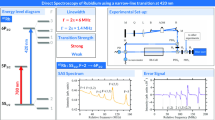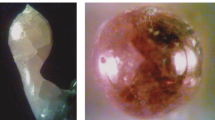Abstract
The temperature dependence of the selective emission intensity of the R1 line upon laser-thermal heating of ruby is studied and explained by competition of radiative and nonradiative relaxation processes.
Similar content being viewed by others
Avoid common mistakes on your manuscript.
INTRODUCTION
The photoluminescence spectra of ruby crystals Al2O3: Cr3+ are determined by the transitions from the excited electronic states of impurity Cr3+ ions to the ground 4A2 state [1–3]. At temperature T = 300 K, the intense R1 and R2 lines at wavelength λ ≈ 694 nm correspond to the 2E → 4A2 transitions and the weak R′ bands at λ = 670 nm and λ ≈ 630 nm correspond to the 2T1 → 4A2 and 4T2 → 4A2 transitions. The anti-Stokes luminescence of the R line of ruby was observed upon two-photon absorption of single pulses of a neodymium-glass laser with a duration of 25 ns at λ ≈ 1.06 µm [4] and periodic femtosecond pulses of a Ti:sapphire laser at λ = 800 nm [5]. Temperature quenching of the luminescence of the ruby R lines occurs at temperatures T > 250 K [2]. Emission at λ = 694 nm was recorded upon diamond cutting, grinding, and polishing of ruby, but the mechanism of its excitation has no satisfactory explanation [6].
The integral spectra of the thermal emission of Al2O3:Cr3+ single crystals in the range of λ = 400–800 nm upon heating by a cw electric-discharge СО2 laser with λ = 10.6 µm were measured and experimentally studied for the first time in [7, 8]. The spectra represent a superposition of the selective emission (SI) spectra of electronic transitions of impurity Cr3+ ions and the pedestal of the continuous thermal emission spectrum of the Al2O3 matrix [7] and depend on the crystal temperature.
The aim of the present work is to experimentally study and interpret the temperature dependence of the R1 line intensity upon continuous laser thermal heating of ruby.
EXPERIMENTAL
We studied the thermal emission spectra of laser ruby single crystals Al2O3:0.03%Cr3+ with a diameter of 5 mm. The single crystals were heated to a temperature exceeding 1000 K by a cw electric-discharge СО2 laser with a power of ~30 W at wavelength λ = 10.6 µm. The temperature in the laser spot on the polished single crystal face was varied by varying the time of heating by a focused laser beam with emission intensities in the range of 1–20 kW/cm2. The ruby thermal emission spectra were recorded on an AvaSpec-2048 spectrometer with a 300-lines/mm diffraction grating, a dispersion range of 200–1100 nm, a receiving array with 2048 pixels and a spectral resolution of 0.04 nm, and a fiber-optic input oriented on the laser spot at a distance of 3–5 cm from the crystal. The spectrometer sensitivity was corrected by the spectrum of a photometric standard lamp (Tokyo Shibaura Electric Co. Ltd. 72, Japan). The error of the spectrometer sensitivity calibration was 15%.
Figure 1 shows the temperature dependence of the experimental emission spectra of Al2O3:0.03%Cr3+, which were recorded after continuous 1-s laser–thermal heating of the single crystal [8]. The spectra represent a superposition of the continuous thermal emission spectrum of the crystal matrix and the selective emission of the electronic lines of Cr3+ ions. Figure 2 shows a typical selective emission spectrum of the ruby R lines in comparison with the photoluminescence spectrum (L) excited by a diode laser at λ = 405 nm. The peak of the R1 line in the thermal emission spectrum is shifted to long wavelengths with respect to the L peak due to the temperature dependence of the wavelength, which is described by the formula ν(R1) = 14 450–0.158T cm–1 [9], where ν(R1) is the wave number of the R1 line of the 2E → 4A2 transitions. Figure 3 shows the time dependences of temperature T and the R1 line emission intensity I calculated from the measured spectra shown in Fig. 1. Figure 4 presents temperature dependence I(T) of the R1 intensity calculated from the time dependences of T and I given in Fig. 3.
MODEL OF THE R1 LINE SELECTIVE EMISSION
Based on the principle of superposition of oscillators, the intensity of the spectra of impurity crystals can be represented in the form
where emissivity ε(λ, T) is equal to the quantum efficiency of emission at λ and Т, γ21(λ) and θ21(λ, Т) are the probabilities of spontaneous and nonradiative transitions between the crystal energy levels with populations N2 and N1, and σ in the Stefan–Boltzmann constant.
The sum of the probabilities in the denominator of (2) is equal to reciprocal luminescence lifetime τ(T). Temperature dependence τ(T) for the ruby R1 line is given in [10]. Figure 5 presents the temperature dependence of the reciprocal luminescence lifetime θ = 1/τ.
Using the presented temperature dependence of probability θ and the value 1/γ21(694 nm) = 3 ms, we calculated the quantum efficiency ε of the selective emission of the R1 ruby line by formula (2). Dependence ε(R1) given in Fig. 6 shows that an increase in thermal losses upon relaxation in the crystal leads to a decrease in the quantum efficiency. The use of ε(R1) in the Stefan–Boltzmann law (1) makes it possible to find the temperature dependence of selective emission of ruby at the R1 line wavelength (Fig. 7). The shape of the calculated dependence agrees with the shape of the experimental curve presented in Fig. 4.
CONCLUSIONS
Thus, using the model of relaxation processes, we explained the experimentally measured temperature dependence of the intensity of the R1 line selective emission spectra upon laser-thermal heating of ruby. The intensity increases at low temperatures (below Т ≈ 540 K) due to the dominance of multiphonon excitation [11] and decreases with further increase in temperature due to increasing probability of nonradiative relaxation. These processes also explain dependence I(T) upon mechanical treatment of ruby [6].
Selective emission of the R1 line can be used in thermometry and in investigation of physicochemical processes on the ruby surface at high thermal loads.
REFERENCES
A. J. Misu, Phys. Soc. Jpn. 19, 2260 (1964).
P. Kisliuk and C. A. Moore, Phys. Rev. 60, 307 (1967).
W. H. Fonger and C. W. Struck, Phys. Rev. B 11, 3251 (1975).
G. M. Zverev, T. N. Mikhailova, and V. A. Pashkov, Sov. Phys. JETP 28, 75 (1969).
L. Yang, Y. Dong, D. Chen, C. Wang, N. Da, X. Jiang, C. Zhu, and J. Qiu, Opt. Express 13, 7893 (2005).
T. Katsumata, S. Komuro, and H. Aizawa, J. Lumin. 154, 511 (2014).
V. M. Marchenko and V. V. Kiselev, J. Appl. Spectrosc. 83, 996 (2016).
V. M. Marchenko, Phys. Wave Phenom. 26, 1 (2018).
D. D. Ragan, Fi. Gustavsen, and D. Schiferl, J. Appl. Phys. 72, 5539 (1992).
Z. Zhang, K. T. V. Grattan, and A. Palmer, Phys. Rev. B 48, 7772 (1993).
R. M. Sova, M. L. Linevsky, M. E. Thomas, and F. F. Mark, APL Tech. Digest. 3, 368 (1992).
Author information
Authors and Affiliations
Corresponding author
Ethics declarations
The authors declare that they have no conflict of interest.
Additional information
Translated by M. Basieva
Rights and permissions
About this article
Cite this article
Marchenko, V.M., Shakir, Y.A. Temperature Dependence of Selective Emission Intensity of the R1 Line upon Laser–Thermal Heating of Ruby. Opt. Spectrosc. 128, 695–697 (2020). https://doi.org/10.1134/S0030400X20060144
Received:
Revised:
Accepted:
Published:
Issue Date:
DOI: https://doi.org/10.1134/S0030400X20060144











